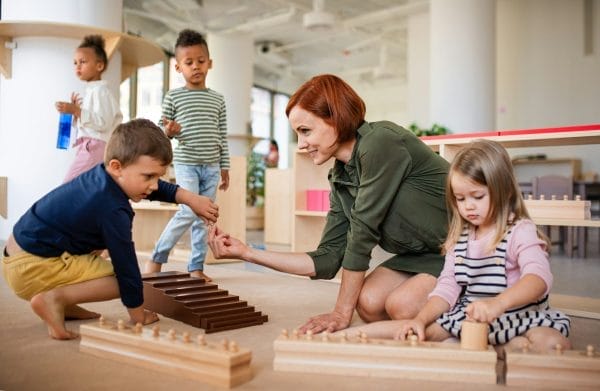Montessori Public Schools: Choosing the Best School for Your Child
Education is a fundamental aspect of a child’s development, and choosing the right school can have a profound impact on their future. Within the diverse landscape of educational options available to parents and guardians, Montessori public schools present a unique blend of a philosophy-centered approach within the accessibility of the public education system.
This article sheds light on what Montessori public schools are, how they compare to traditional public schools, and provides a list of public Montessori schools, including the Horizon Montessori public schools, to help parents make informed decisions.

What are Montessori Public Schools?
![]()
Montessori public schools are educational institutions that marry the principles of Montessori education with the inclusivity and free access of the public school system. Montessori education is a child-centered educational approach developed by Dr. Maria Montessori in the early 1900s. It emphasizes hands-on, experiential learning, and fosters independence by encouraging children to make choices about their learning journey within a structured environment.
Unlike private Montessori schools, which can be costly and exclusive, Montessori public schools offer this unique educational approach to a broader demographic, often funded by state and federal education budgets. Here, children from different socioeconomic backgrounds have the opportunity to experience a Montessori education without the barrier of tuition fees.
Montessori Schools vs. Public Schools
![]()
Understanding the differences between Montessori schools and traditional public schools can help parents determine the best educational path for their children. Here are some key distinctions:
- Learning Approach: Montessori schools use a hands-on approach to learning that encourages self-directed activity and allows children to learn at their own pace. In contrast, traditional public schools often follow a more structured curriculum with a teacher-led approach.
- Classroom Environment: Montessori classrooms are known for their mixed-age groups, which promote peer learning and social development. Traditional public school classrooms typically group children by age and grade levels.
- Assessment: Montessori education often avoids grades and standardized tests, focusing instead on individual progress and development. Traditional public schools usually employ grades and standardized testing as measures of student achievement.
- Role of the Teacher: In Montessori schools, teachers act as guides and facilitators rather than traditional instructors. This allows students more autonomy. In public schools, teachers generally lead the classroom and control the pace and content of learning.
These differences highlight a fundamental shift in how education is perceived and delivered within Montessori public schools compared to their traditional counterparts.
Montessori in Public Schools
![]()
The integration of Montessori methods into public schools is not without its challenges. The need to adhere to state educational standards and the constraints of public funding can sometimes limit the full application of Montessori principles. However, many public Montessori schools have found innovative ways to incorporate key elements of Montessori education while meeting the requirements of the public school system.
One example of successful integration is the inclusion of Montessori materials and activities within the standard curriculum. Teachers trained in the Montessori method use these resources to enhance student engagement and foster a love of learning. Additionally, public Montessori schools create environments that promote independence and respect for each child’s individual learning journey, aligning with Montessori’s core values.
List of Public Montessori Schools
![]()
There is a growing number of Montessori public schools across the United States. To provide a glimpse into this expanding educational option, here is a list of public Montessori schools that have gained recognition for their programs:
- Horizon Montessori Public Schools (with multiple locations)
- Montessori Academy at Henry C. Pate Elementary (San Antonio, TX)
- Museum Magnet School (St. Paul, MN)
- City Garden Montessori School (St. Louis, MO)
- Jonathan Montessori School (Chaska, MN)
This list is not exhaustive, and parents are encouraged to search for additional Montessori public schools in their local areas. Many states have online directories and support networks for Montessori education that can assist in this search.
Horizon Montessori Public Schools
![]()
Horizon Montessori Public Schools serve as a prime example of Montessori education within the public school system. These schools are part of a network that offers Montessori education to a diverse student population. Horizon schools are known for their commitment to maintaining the integrity of Montessori methods while providing education free of charge.
Horizon Montessori Public Schools focus on creating learning environments that cater to the whole child, including their cognitive, emotional, and social development. The schools emphasize the importance of community and strive to involve parents and guardians in the educational process, building a strong foundation for lifelong learning.
Frequently Asked Questions
![]()
What is a Montessori public school?
A Montessori public school is a government-funded school that applies the educational philosophy and methods of Maria Montessori. It emphasizes self-directed learning, mixed-age classrooms, and hands-on learning with specially designed materials.
How is Montessori different from traditional education?
Montessori education focuses on individual learning and development. Unlike traditional education with a one-size-fits-all approach, Montessori allows children to learn at their own pace and choose activities based on their interests. Teachers guide rather than instruct, and students learn concepts from working with materials rather than direct instruction.
Can any child attend a Montessori public school?
Yes, any child can attend a Montessori public school as long as they meet the school’s enrollment requirements, which usually include living within the school district or zone. Admission may sometimes be determined by a lottery if the school has more applicants than available spots.
Is Montessori suitable for children with special needs?
Montessori can be suitable for children with special needs because it offers individualized learning and teaching methods that can be adapted to a child’s unique abilities and challenges. However, it’s important to talk to the school to ensure that they have the resources and expertise to support your child’s specific needs.
How are teachers trained in Montessori public schools?
Montessori teachers are typically trained through Montessori teacher education programs, which may include a combination of academic coursework and hands-on classroom experience. Certification often requires a comprehensive understanding of Montessori philosophy, child development, and the use of Montessori materials.
What does a typical day look like in a Montessori public school?
A typical day in a Montessori public school includes a block of uninterrupted work time where students choose their activities, work individually or in small groups, and move at their own pace. There are also times for communal activities, outdoor play, and subject-specific lessons.
Are Montessori public schools free?
Yes, Montessori public schools are free since they are funded by the government. There may be some costs for materials or field trips, but tuition is not charged.
How does assessment work in Montessori public schools?
Assessment in Montessori public schools is often ongoing and based on teacher observations, student work, and portfolios rather than traditional grades and tests. Some Montessori schools may also use standardized tests to comply with state or federal requirements.
Will my child transition easily to a traditional school after Montessori?
Transitioning to a traditional school after Montessori can vary for each child. Montessori students often adapt well because they’ve developed a love for learning, self-discipline, and social skills. However, the change in structure and teaching methods may require some adjustment.
How can I support my child’s Montessori education at home?
To support your child’s Montessori education at home, create an organized and child-friendly environment, encourage independence, allow them to pursue their interests, and model lifelong learning. It’s also helpful to establish routines that align with the Montessori principles they experience at school.
Conclusion: The Future of Montessori Public Schools
![]()
As the educational landscape continues to evolve, Montessori public schools represent a significant innovation in public education. These schools offer a unique approach that respects the individuality of each child and promotes a deep love of learning. While there are challenges in merging Montessori principles with the public education system, the success of schools like Horizon Montessori Public Schools demonstrates the immense potential of this educational model.
Parents interested in Montessori public schools should research their local options, visit schools, and talk to educators to determine if this educational approach aligns with their child’s needs. With a growing list of public Montessori schools, families from all walks of life have the opportunity to choose an educational path that fosters independence, creativity, and a strong sense of community for their children.
In summary, Montessori public schools offer a compelling alternative to traditional public education, providing a holistic approach to learning that prepares children not just for academic success, but for life. As these schools become more prevalent, they may pave the way for broader changes in the public education system, emphasizing the importance of individualized learning and the potential within every child.




